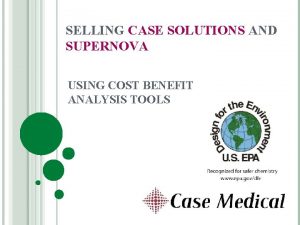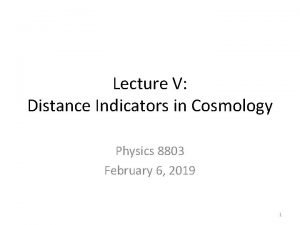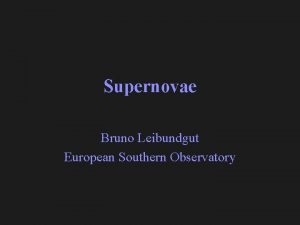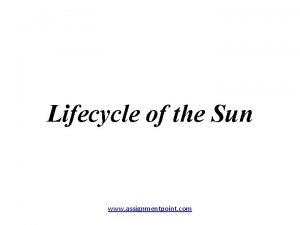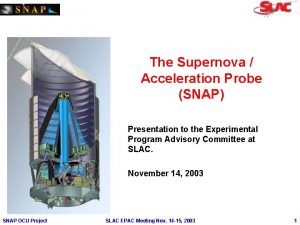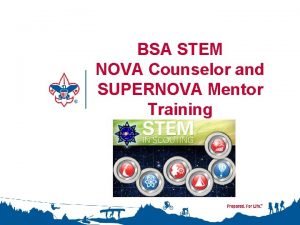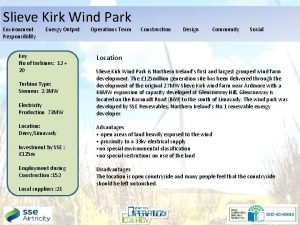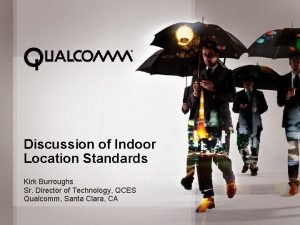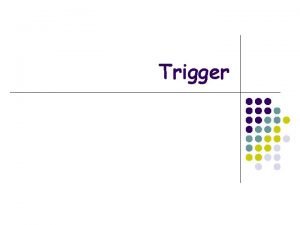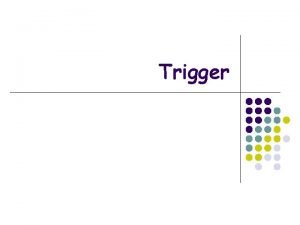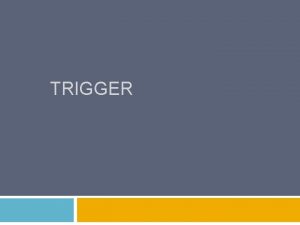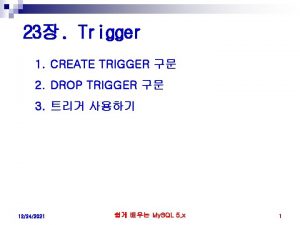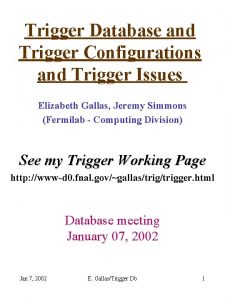Options for the Supernova Trigger Kirk T Mc








- Slides: 8

Options for the Supernova Trigger Kirk T. Mc. Donald Princeton University (Jan. 16, 2009) K. T. Mc. Donald Boo. Ne Collaboration Meeting Jan. 23, 2009 1 Boo. NE

Opportunity for a Supernova “Trigger” The primary trigger in Boo. NE will be the Accelerator-Neutrino Trigger, based on a signal in the PMTs inside the cryostat due the relevant Booster and Nu. MI spills. In addition, we would like to temporarily record “all” data such that if a trigger is received from an external “Supernova Watch”, we could make a permanent record of the time interval that might contain supernova neutrino interactions. At present, the external Supernova Trigger might come up to one hour after the supernova neutrinos. http: //www. astro. princeton. edu/%7 Ealicia/SN 2008 D/Soderberg_Nature_SN 2008 D. pdf reports a satellite detection of a 400 -s-long burst of x-rays from an extragalactic supernova on 9 Jan 2008. If one of the current X-ray sensitive satellites triggers on a nearby supernova, it will immediately be circulated via the GRB Circulars Network (GCN; http: //gcn. gsfc. nasa. gov ) since it will appear to the on-board software as a gamma-ray burst (GRB). Upon ground-based analysis (several minutes later), a human on the satellite team will send an additional email to the GCN circular list… Hence, there is a desire for temporary storage of a rather large amount of data for 1 hour. ROXY Supernova Watch, $25: K. T. Mc. Donald Boo. Ne Collaboration Meeting Jan. 23, 2009 2 Boo. NE

We Should Minimize the ADC Sampling Rate Wire (and wire-plane) spacing of d = 3 mm implies an effective “shaping” time wire d / v = 3/1. 6 = 1. 9 s. (See Doc. DB 257 by B. Yu for detailed confirmation using the “weighting” method. ) Electron diffusion contributes diffusion √(2 D t) = √(2 D x/v). Using D = 15 cm^2/s (Doc. DB 280), diffusion, max = 2. 2 s, diffusion = 1. 5 s, and ¾ of all “hits” have diffusion > 1. 1 s. C. Thorn notes (Doc. DB 289) that the above may apply only to TRANSVERSE diffusion, while LONGITUDINAL diffusion may well follow the “Einstein” value D ~ 5 cm 2/c (as used by ICARUS). If so, diffusion, max = 0. 9 s, diffusion = 0. 6 s, and ¾ of all “hits” have diffusion > 0. 45 s. In addition, the preamp adds a “shaping” time preamp 1 s (actual value to be determined). Altogether, = 2. 6 s and min = 2. 1 s if D = 15 cm 2/s, and = 2. 2 s D = 5 cm 2/s. [This is driven by the wire (and wire-plane spacing). ] A criterion derived from the Nyquist-Shannon sampling theorem is that it suffices to sample twice per overall shaping time (5 samples over the FWHM), which would be less that 1 MHz for the Boo. NE TPC. Rate. To reduce the burden of unnecessary data, and to make a Supernova Trigger feasible, I strongly recommend that we reduce the ADC sampling rate to 1 MHz. [Technical footnote: The actual sampling rate can be higher, but we should not record more than one sample per s. ] K. T. Mc. Donald Boo. Ne Collaboration Meeting Jan. 23, 2009 3 Boo. NE

The Accelerator-Neutrino Trigger/DAQ At present, we consider that a neutrino interaction should be associated with 4. 8 ms of data. If the ADCs sample at 1 MHz, the raw data corresponding to 4. 8 ms is about 100 MB (20 GB/s). We believe that with “lossless” (Huffman) coding, we could reduce this event size to 10 MB. This data is collected in 150 front-end boards, with 67 k. B/(4. 8 ms event) each. The rate of Accelerator-Neutrino Triggers will be ¼ Hz, while beam spills occur at 10 Hz. To accommodate fluctuations between triggers of up to, say, 20 s = 5 times the average time between triggers, we need to store up to 200 4. 8 -ms data blocks in the front-end boards, pending the next Accelerator-Neutrino trigger. Need about 15 MB of storage per front-end board to buffer the data for Accelerator-Neutrino triggers. After each Accelerator-Neutrino Trigger, the corresponding 10 MB of data would be read out to a single PC, which records it to hard disk, and performs online event monitoring. The Supernova Trigger should be as compatible as possible with the above scenario. Footnote: The 1. 5 TB Seagate drives can write steadily at 100 MB/s. Hence we could write all beam spill data to a single disk at 10 Hz, if the event size is indeed only 10 MB. K. T. Mc. Donald Boo. Ne Collaboration Meeting Jan. 23, 2009 4 Boo. NE

The Data Burden for the Supernova Trigger We believe that it is reasonably straightforward to include 8 GB of DRAM on each of the 150 frontend board, s 1. 2 TB of online DRAM memory. This is enough for 120, 000 4. 8 -ms data blocks with “lossless” coding, 600 s of continuous data. However, it is desired to store “all” data for one hour, pending a possible Supernova Trigger from the astrophysics community. Options: 1. Reduce the size of the data stream by an additional factor of 6 via “lossy” cuts, so that 1 hour of data could be stored on the front-end boards. [I do not advocate use of “lossy” cuts for the accelerator neutrino events, but they could be OK for the simpler topology of supernova neutrino events. ] 2. Add a hard drive to each front-end board (50 GB minimum). [This is probably the simplest/cheapest solution if we insist of recording only “lossless” data. ] 3. Send “all” data off the front-end boards into a PC farm where it is temporarily stored on hard drives. 4. Apply a “muon veto” that reduces the size of the “lossless” data stream by at least 6. K. T. Mc. Donald Boo. Ne Collaboration Meeting Jan. 23, 2009 5 Boo. NE

An External Muon Veto System A practical veto system would have to be close to the cryostat, under the dirt overburden. Then, this system would veto tracks from neutrino interactions that leave the cryostat. This is not an issue for supernova neutrinos, whose energies are so low that no tracks leave the cryostat if the vertex is within the TPC. This veto system would NOT be used in the Accelerator-Neutrino Trigger (although it would be useful in the data analysis in confirming TPC tracks identified as muons as actually such). [There is no need to use a veto in that trigger as the rate is already sufficiently low -- if we use the LAr scintillation trigger as generally agreed. ] K. T. Mc. Donald Boo. Ne Collaboration Meeting Jan. 23, 2009 6 Boo. NE

What Would an External Muon Veto System Veto? The front-end boards are continually processing the TPC data, without any “trigger”. So, the base system includes no “trigger” that could be vetoed by the muon system. We must first form a Candidate Supernova trigger, and then veto this. The only option I see for this is a trigger based on the cryostat PMTs. I believe that these will have a coincidence rate of 12 k. Hz due to muons. If the energy threshold is too low, the cryostat-PMT rate will be dominantly due to radioactivity of the LAr, the PMTs, the wire cage, and the cryostat wall. Rates in the 2 liter WARP detector: (in Gran Sasso, so no muon contribution) In a large detector like Boo. NE, with limited PMT coverage, it will be necessary to set an energy threshold of several Me. V, The Candidate Supernova trigger would be inefficient for low-energy supernova neutrino interactions. This scheme not desirable from a physics perspective, although technically feasible. K. T. Mc. Donald Boo. Ne Collaboration Meeting Jan. 23, 2009 7 Boo. NE

Summary of Supernova Trigger Options • Reduce the ADC sampling rate to 1 MHz (without loss of physics information). • Get an external supernova trigger within 600 sec of the first arrival of supernova events on Earth. Then wouldn’t need any additional data compression, or any veto. But, this is not likely. • Make stronger (“lossy”) cuts online. An additional factor of 6 reduction in event size (beyond “lossless” compression of 1 MHz ADC sampling) would permit 1 hour storage of "all" data in DRAM on the front-end boards. • Store “lossless” data in hard drives on the front-end boards. This could permit up to 1 day of data to be so stored. • Store “lossless” data in hard drives on a PC farm. • Use an external muon veto system to veto Candidate Supernova triggers from the cryostat-PMTs. This would be inefficient for low-energy supernova neutrinos. K. T. Mc. Donald Boo. Ne Collaboration Meeting Jan. 23, 2009 8 Boo. NE
